As another U.S. presidential election approaches, speculation about its potential impact on financial markets intensifies. Many investors contemplate adjusting their portfolios based on anticipated outcomes. However, historical evidence and financial wisdom suggest that while elections are crucial for shaping public policy, their influence on long-term investment strategies is often overstated.

The Complexity of Market Reactions
Financial markets are influenced by numerous factors, making predictions based solely on election results unreliable. Vanguard’s research dating back all the way to the year 1860 demonstrates this complexity, showing no statistically significant difference in performance between election and non-election years for a balanced 60/40 portfolio. This underscores the futility of basing investment decisions solely on political cycles.
Comparing presidential election years versus non-presidential election years: 60% stock/40% bond portfolio returns show no statistical difference
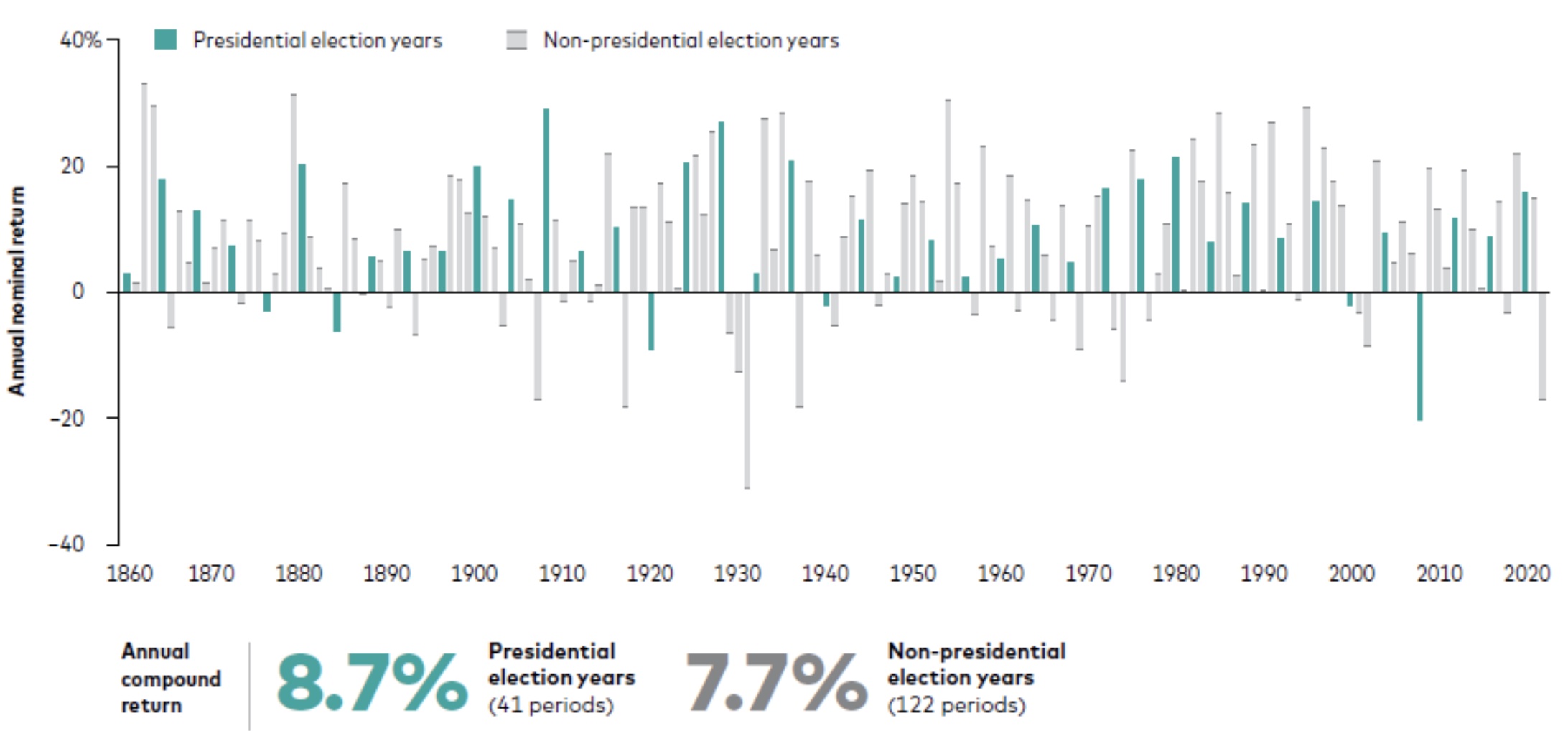
Sources: Vanguard calculations, based on data from Global Financial Data (GFD) as of December 31, 2022. The 60% GFD US-100 Index and 40% GDS US Bond Index, is calculated by GFD. The GFD US-100 Index includes the top 25 companies from 1825 to 1850, the top 50 companies from 1850 to 1900, and the top 100 companies by capitalization from 1900 to the present. In January of each year, the largest companies in the United States are ranked by capitalization, and the largest companies are chosen to be part of the index for that year. The next year, a new list is created and chain-linked to the previous year’s index. The index is capitalization-weighted, and both price and return indices are calculated. The GFD US Bond Index uses the U.S. government bond closest to a 10-year maturity without exceeding 10 years from 1786 until 1941 and the Federal Reserve’s 10-year constant maturity yield beginning in 1941. Each month, changes in the price of the underlying bond are calculated to determine any capital gain or loss. The index assumes a laddered portfolio that pays interest monthly.
Markets are highly efficient at pricing in current events, swiftly incorporating new information, including election outcomes, into asset valuations. Attempting to attribute market movements to a single cause overlooks the multitude of variables at play.
Contrary to popular belief, periods surrounding presidential elections have often experienced lower volatility than broader timeframes. Analysis from 1984 to 2020 reveals that the S&P 500’s annualized volatility was slightly lower in the 100 days before and after elections compared to average volatility over the same period. This suggests that while elections generate headlines, their direct impact on market stability may be less significant than anticipated.
Historical Performance Perspective
Examining markets on both a yearly and a full presidential term basis reveals that a balanced portfolio has historically provided meaningful returns while managing risk. Since 1936, only one 4-year presidential term out of 22 elections resulted in negative annualized returns for a balanced portfolio.
Yearly 60s/40b returns have been positive most of the time regardless of which party held the presidency
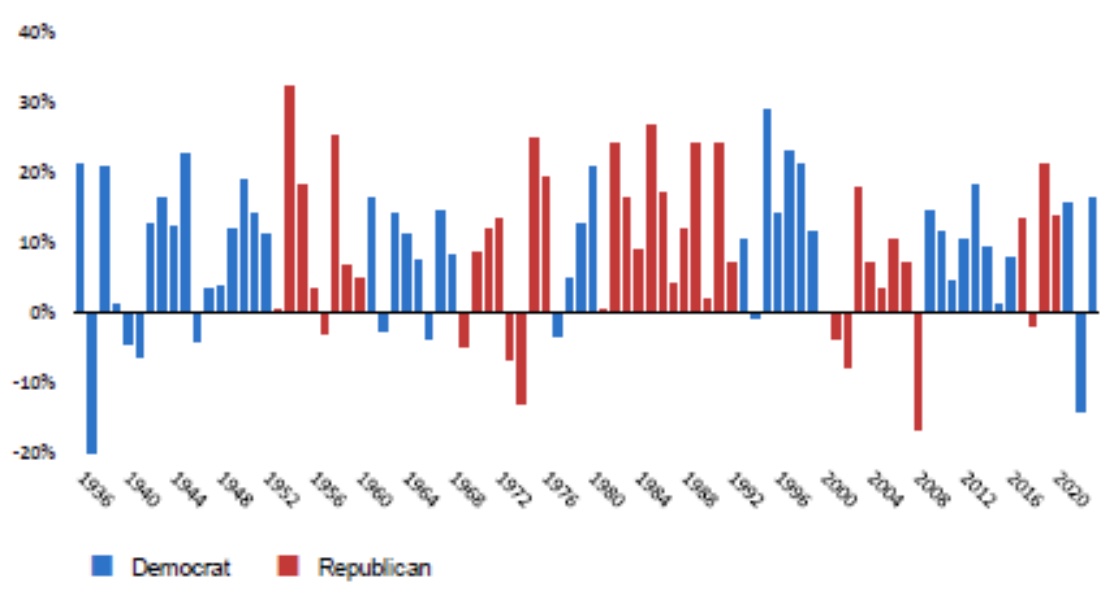
4-Year annualized 60s/40b returns provide even further confirmation
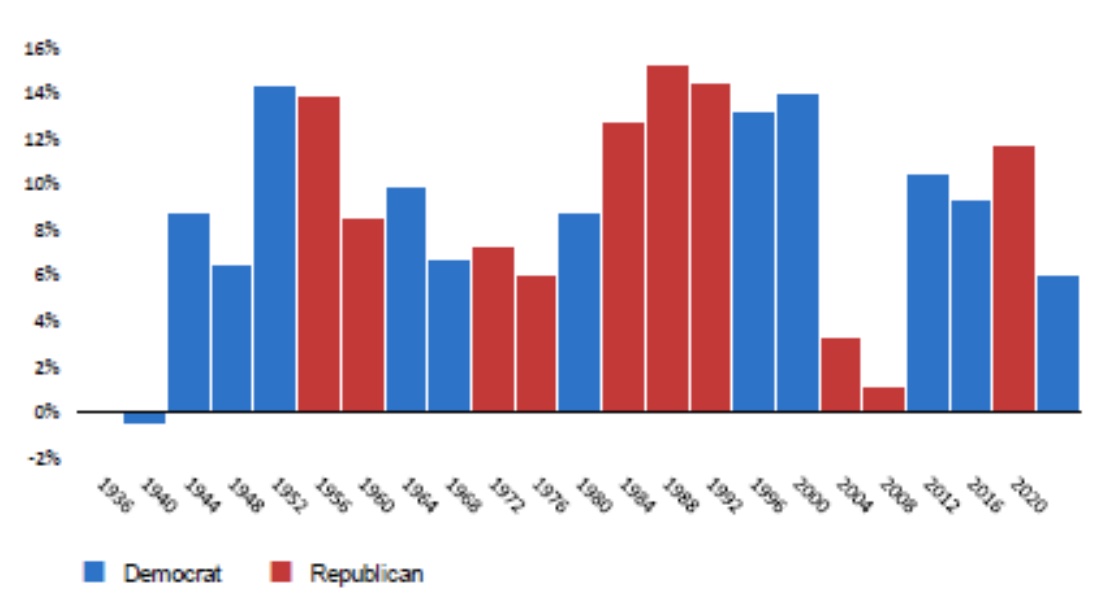
Past performance is no guarantee of future results. The returns of an index do not represent actual investor returns as one cannot invest directly in an index.
Sources: Vanguard calculations based no data provided by Morningstar and SBBI, as of December 31, 2023.
Notes: A 60s/40b model portfolio consists of 60% IA SBBI US Large Stock Total Return Index and 40% IA SBBI US Intermediate-Term Government Total Return Index.
Recent elections provide valuable insights. Following Obama’s 2008 victory, initial concerns gave way to robust market performance, with the S&P 500 growing at an annualized rate of 14.5% over eight years. Similarly, Trump’s unexpected win in 2016 initially sparked uncertainty − yet markets rallied, gaining 13.6% a year by November 2020. These examples illustrate that while campaign promises and policies may influence sentiment, broader economic factors often exert more substantial long-term influence on market outcomes.
Contested Elections and Market Resilience
It’s important to address the impact of contested elections, such as the 2000 Bush vs. Gore scenario. Historically, even these periods of heightened uncertainty have not led to dramatic shifts in investment performance. Markets have demonstrated remarkable resilience and adaptability in the face of prolonged electoral uncertainty.
Stocks have been contested elections before
Case Study: 2000 U.S. Presidential Election
S&P 500 performance, 1/1/00 through 1/13/01
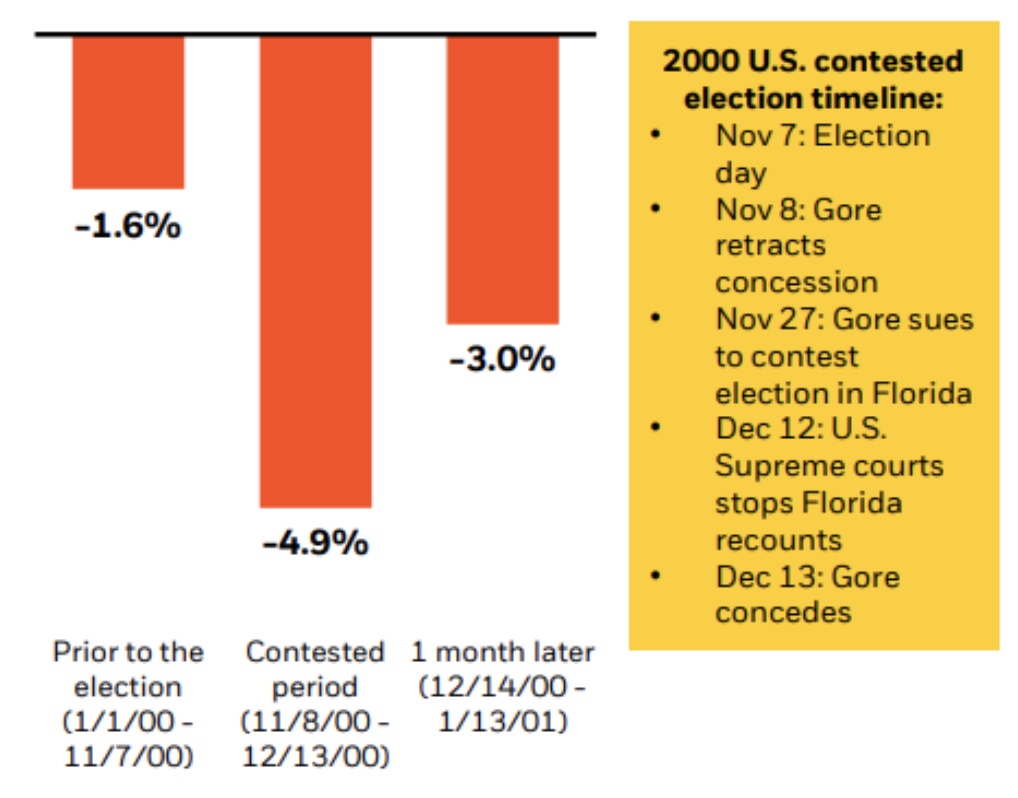
Case Study: 2020 U.S. Presidential Election
S&P 500 performance, 1/1/20 through 1/20/21
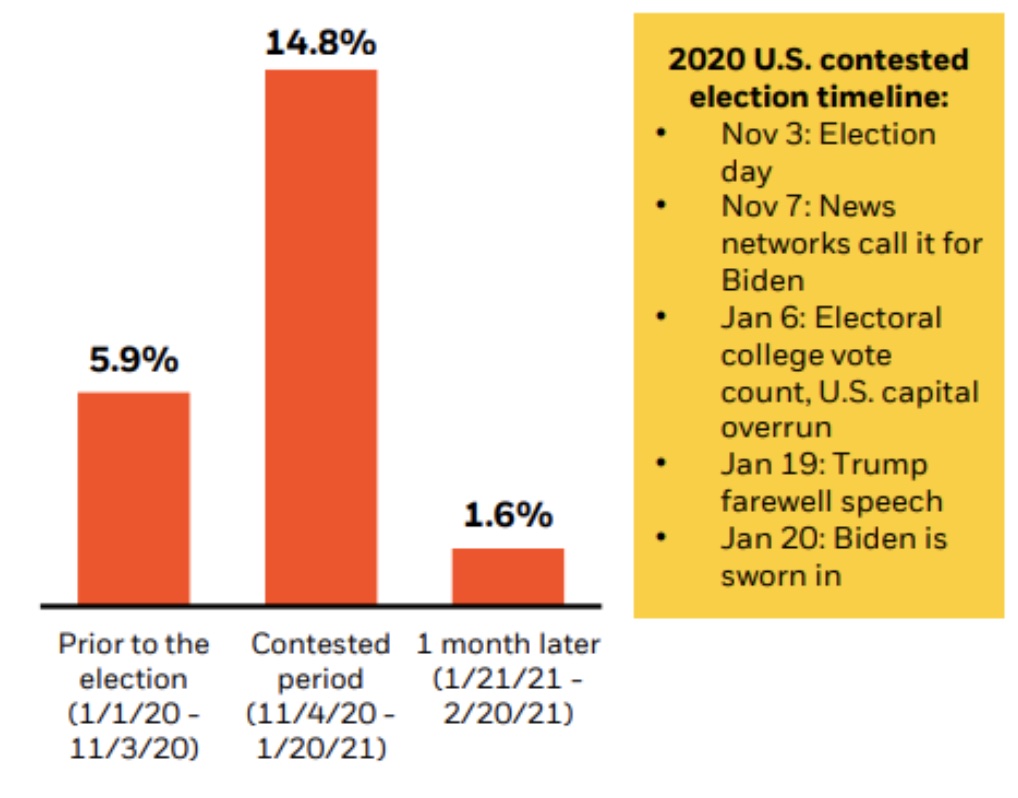
Morningstar as of 12/31/23. Stock market represented by the S&P 500 Index. Past performance does not guarantee or indicate future results. Index performance is for illustrative purposes only. You cannot invest directly in the index.
The 2000 election, which wasn’t decided until December of that year, provides a valuable case study. While there was initial volatility, as shown in this chart from BlackRock, markets quickly stabilized once the outcome was determined. Keep in mind, this was also during a period of the dot-com bubble collapsing − so markets were already experiencing a downturn. This example underscores the market’s ability to process and adapt to political uncertainty, further supporting the argument for maintaining a steady investment approach regardless of electoral outcomes. During the initial uncertainty around the 2020 election, markets rallied meaningfully.
Global Elections in 2024
Looking beyond U.S. borders, it’s crucial to consider the broader global political landscape. 2024 is set to be a significant year for elections worldwide, with several major economies heading to the polls. Key elections beyond the U.S. include India, the European Parliament, the UK, France, Mexico, South Africa and Taiwan.
These political developments will undoubtedly capture international attention and may influence investor sentiment on a global scale. However, it’s important to note that while markets often show initial reactions to election results, they frequently revert to previous levels or readjust based on broader economic factors.
For instance, after the Brexit referendum in 2016, global markets experienced immediate volatility, with the FTSE 100 dropping sharply. However, within a week the index had recovered its losses and even reached new highs. Similarly, the surprise outcome of the 2016 U.S. presidential election caused a brief market dip, followed by a quick recovery and subsequent rally.
These examples illustrate that while elections can trigger short-term market movements, long-term trends are typically driven by fundamental economic factors rather than political events alone. This pattern of initial reaction followed by reversion further supports the argument for maintaining a steady, long-term investment approach.
The Role of Investor Discipline
At Cardinal Point, we advocate for maintaining discipline and a long-term perspective in all investment strategies. Our experience underscores the importance of sticking to a well-crafted financial plan through various market cycles, including election seasons. Emotions and short-term volatility should not dictate investment decisions that are intended to achieve long-term financial goals.
Additional Supporting Evidence
- Sector Performance Variability: Research by Fidelity Investments shows that different market sectors can perform well under various administrations, regardless of party affiliation. This suggests that diversification across sectors is more crucial than aligning investments with political expectations.
- Global Market Influence: As global markets become increasingly interconnected, U.S. presidential elections have a diminishing impact on overall market performance. International economic factors, trade relationships, and global events often play a much more significant role in shaping market trends.
- Corporate Adaptability: Companies have demonstrated their ability to adapt to changing political landscapes. A study by the National Bureau of Economic Research found that firms often adjust their operations and strategies in response to policy changes, mitigating potential negative impacts on their long-term performance.
- Long-Term Market Trends: Data from Dimensional Fund Advisors shows that over the past century, the U.S. stock market has trended upward regardless of which party controls the White House. This long-term growth trajectory emphasizes the importance of staying invested rather than trying to time the market based on election cycles.
- The Perils of Market Timing: Numerous studies, including those by Dalbar Inc., consistently show that investors who attempt to time the market based on external events, including elections, often underperform compared to those who maintain a consistent, long-term investment strategy.
Conclusion: Maintaining a Steady Course
While presidential elections are significant political events, their impact on long-term investment portfolios is often less substantial than commonly perceived. Historical data, market research, and financial principles consistently demonstrate the resilience of markets through political transitions. By maintaining a disciplined approach, adhering to a well-crafted financial plan, and focusing on fundamental investment principles, investors can navigate election cycles with confidence and work toward achieving their long-term financial objectives.
Indexes used: Cash represented by ICE BofAML 3M U.S. Treasury Notes. MSCI Canada, MSCI World Ex USA and U.S. Russell series used for Large Value, Large Blend, Large Growth, Mid Value, Mid Blend, Mid Growth, Small Value, Small Blend, Small Growth representations. Alternatives in USD and CAD charts represented by Credit Suisse Liquid Alternative TR USD . Nominal Broad U.S. Dollar index for USD comparisons. Additional representations in CAD: Canadian Bonds- Bloomberg Barclays Global Canada, Canadian Stocks- S&P/TSX Composite TR, U.S. Stocks S&P 500 TR, International Stocks- MSCI EAFE NR. Additional representations in USD: Short International Bonds- FTSE WGBI 1-5Yr Hdg, U.S. stocks- S&P 500, U.S. Value- Russell 1000 Value, U.S. Small- Russell 2000, U.S. REITs- DJ U.S. Select REIT, Canadian Stocks- FTSE Canada, Intl Stocks- MSCI World Ex USA Large, Emerging Markets- MSCI EM NR.
Sources: Bureau of Economic Analysis, Bureau of Labor Statistics, Bank of Canada, Capital Economics, Bloomberg Economic Calendar, U.S. Department of the Treasury, CME Group, Trading Economics, Dimensional Fund Advisors “How Much Impact Does the President Have on Stocks?” Nov 2022, Vanguard “Investing in an Election Year”, Mar 2024, Fidelity “Election 2024: Anticipating the market impact” May 2024, BlackRock “How the U.S. Election may impact your portfolio” Feb 2024, JP Morgan Guide to the Markets Q2 2024, Morningstar Direct 2024.
Indexes are unmanaged baskets of securities that are not available for direct investment by investors. Index performance does not reflect the expenses associated with the management of an actual portfolio. Past performance is not a guarantee of future results. Foreign securities involve additional risks, including foreign currency changes, political risks, foreign taxes, and different methods of accounting and financial reporting. Emerging markets involve additional risks, including, but not limited to, currency fluctuation, political instability, foreign taxes, and different methods of accounting and financial reporting. All investments involve risk, including the loss of principal and cannot be guaranteed against loss by a bank, custodian, or any other financial institution.